At first, everything went as expected, and as soon as French President Emmanuel Macron announced the extension of restrictive measures until May 11, the single European currency confidently began to decline. It turns out that in Europe, despite the steady decline in the number of new cases of coronavirus infection, the quarantine will last for a long time. This means that the economy will fall deeper into recession. And there is no doubt that if the second largest country in the eurozone takes this step, then other European countries will follow its example. Moreover, in Spain, Italy and Germany, the situation with coronavirus is somewhat worse than in France. And all this against the backdrop of US President Donald Trump's clear desire to cancel all sorts of restrictive measures as soon as possible and allow the economy to work at full capacity. After all, the economy was his main electoral advantage. But the coronavirus has confused all the cards. The coronavirus epidemic and the need to restrict the movement of people have led to a catastrophic increase in unemployment, and Trump is losing his main weapon in the fight for the White House. But the dollar began to rapidly lose its positions just before the opening of the US session. There has once again been an increase in the number of new cases of coronavirus infection in the United States. This means that there is no need to wait for any cancellation of the quarantine.

Today, macroeconomic statistics should come to the fore, and there will be a lot of them. At the same time, as yesterday, the beginning of the European session could be accompanied by a weakening of the single European currency. The reason will be inflation. In France, it should fall from 1.4% to 0.6%. In Spain, from 0.7% to 0.1%. Well, in Italy, from 0.3% to 0.1%. Thus, we can see a confident step by Europe towards deflation. The data for Germany and the entire eurozone will be published later, if inflation is rapidly falling in three out of the four largest countries in the bloc, then the same thing will happen throughout Europe.
Inflation (France):

However, we could see a repeat of yesterday as soon as the US session opens and the dollar will lose its positions. Again, this may be due to macroeconomic statistics. The fact is that retail sales, which were growing by 4.3% in February, could show a decline of 2.0% by the end of March. Industrial production, which stopped declining in February, even though it showed zero growth, should resume its decline by 1.5%. And it should be noted that this is in annual terms. So the decline in retail sales looks disastrous. Consumer demand is a fundamental factor for the US economy. And you can understand Trump, who wants to launch the economy as soon as possible.
Retail sales (United States):

From the point of view of technical analysis, we see the resumption of the upward movement, where the quotes managed to overcome the previous day's peak of 1.0967 and head towards the psychological level of 1.1000. In fact, buyers have already felt the boundaries of the key value, slowing down the movement within the 1.0990 mark.
Relative to the daily period, an upward movement is recorded from the 1.0775 level, where more than 60% has already been worked out relative to the previous inertia.
We can assume that in the first half of the day, the quote will face a temporary fluctuation within the values of 1.0950/1.0990, where special attention is paid to the upper limit, since it is possible for the eur to strengthen further in a local perspective.
We specify all of the above into trading signals:
- We consider purchase positions higher than 1.1000, with the prospect of a move to 1.1040-1.1080.
- We consider selling positions in the direction of 1.0955 (1.0950).
From the point of view of a comprehensive indicator analysis, we see that the hourly and daily periods reflect an upward trend, signaling a purchase. At the same time, minute intervals work on the existing fluctuation, signaling a sale.

